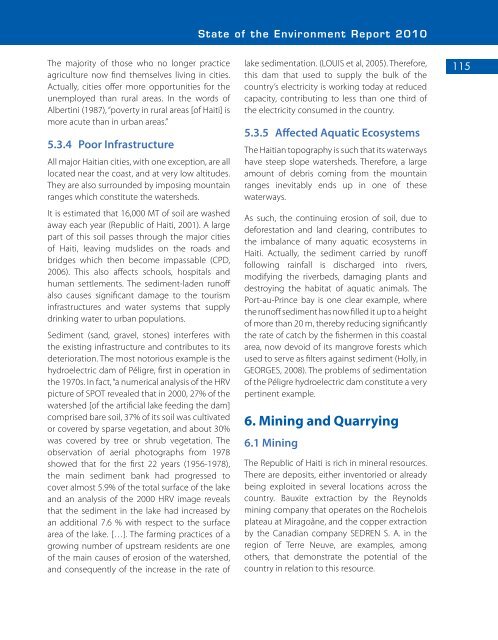GEO Haiti 2010
GEO Haiti 2010
GEO Haiti 2010
You also want an ePaper? Increase the reach of your titles
YUMPU automatically turns print PDFs into web optimized ePapers that Google loves.
State of the Environment Report <strong>2010</strong><br />
The majority of those who no longer practice<br />
agriculture now find themselves living in cities.<br />
Actually, cities offer more opportunities for the<br />
unemployed than rural areas. In the words of<br />
Albertini (1987), “poverty in rural areas [of <strong>Haiti</strong>] is<br />
more acute than in urban areas.”<br />
5.3.4 Poor Infrastructure<br />
All major <strong>Haiti</strong>an cities, with one exception, are all<br />
located near the coast, and at very low altitudes.<br />
They are also surrounded by imposing mountain<br />
ranges which constitute the watersheds.<br />
It is estimated that 16,000 MT of soil are washed<br />
away each year (Republic of <strong>Haiti</strong>, 2001). A large<br />
part of this soil passes through the major cities<br />
of <strong>Haiti</strong>, leaving mudslides on the roads and<br />
bridges which then become impassable (CPD,<br />
2006). This also affects schools, hospitals and<br />
human settlements. The sediment-laden runoff<br />
also causes significant damage to the tourism<br />
infrastructures and water systems that supply<br />
drinking water to urban populations.<br />
Sediment (sand, gravel, stones) interferes with<br />
the existing infrastructure and contributes to its<br />
deterioration. The most notorious example is the<br />
hydroelectric dam of Péligre, first in operation in<br />
the 1970s. In fact, “a numerical analysis of the HRV<br />
picture of SPOT revealed that in 2000, 27% of the<br />
watershed [of the artificial lake feeding the dam]<br />
comprised bare soil, 37% of its soil was cultivated<br />
or covered by sparse vegetation, and about 30%<br />
was covered by tree or shrub vegetation. The<br />
observation of aerial photographs from 1978<br />
showed that for the first 22 years (1956-1978),<br />
the main sediment bank had progressed to<br />
cover almost 5.9% of the total surface of the lake<br />
and an analysis of the 2000 HRV image reveals<br />
that the sediment in the lake had increased by<br />
an additional 7.6 % with respect to the surface<br />
area of the lake. […]. The farming practices of a<br />
growing number of upstream residents are one<br />
of the main causes of erosion of the watershed,<br />
and consequently of the increase in the rate of<br />
lake sedimentation. (LOUIS et al, 2005). Therefore,<br />
this dam that used to supply the bulk of the<br />
country’s electricity is working today at reduced<br />
capacity, contributing to less than one third of<br />
the electricity consumed in the country.<br />
5.3.5 Affected Aquatic Ecosystems<br />
The <strong>Haiti</strong>an topography is such that its waterways<br />
have steep slope watersheds. Therefore, a large<br />
amount of debris coming from the mountain<br />
ranges inevitably ends up in one of these<br />
waterways.<br />
As such, the continuing erosion of soil, due to<br />
deforestation and land clearing, contributes to<br />
the imbalance of many aquatic ecosystems in<br />
<strong>Haiti</strong>. Actually, the sediment carried by runoff<br />
following rainfall is discharged into rivers,<br />
modifying the riverbeds, damaging plants and<br />
destroying the habitat of aquatic animals. The<br />
Port-au-Prince bay is one clear example, where<br />
the runoff sediment has now filled it up to a height<br />
of more than 20 m, thereby reducing significantly<br />
the rate of catch by the fishermen in this coastal<br />
area, now devoid of its mangrove forests which<br />
used to serve as filters against sediment (Holly, in<br />
<strong>GEO</strong>RGES, 2008). The problems of sedimentation<br />
of the Péligre hydroelectric dam constitute a very<br />
pertinent example.<br />
6. Mining and Quarrying<br />
6.1 Mining<br />
The Republic of <strong>Haiti</strong> is rich in mineral resources.<br />
There are deposits, either inventoried or already<br />
being exploited in several locations across the<br />
country. Bauxite extraction by the Reynolds<br />
mining company that operates on the Rochelois<br />
plateau at Miragoâne, and the copper extraction<br />
by the Canadian company SEDREN S. A. in the<br />
region of Terre Neuve, are examples, among<br />
others, that demonstrate the potential of the<br />
country in relation to this resource.<br />
115

















